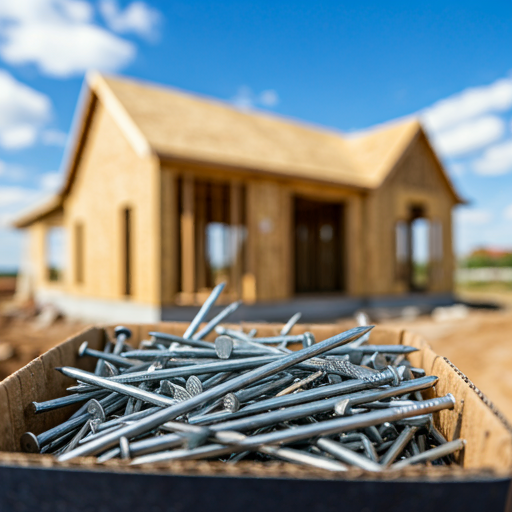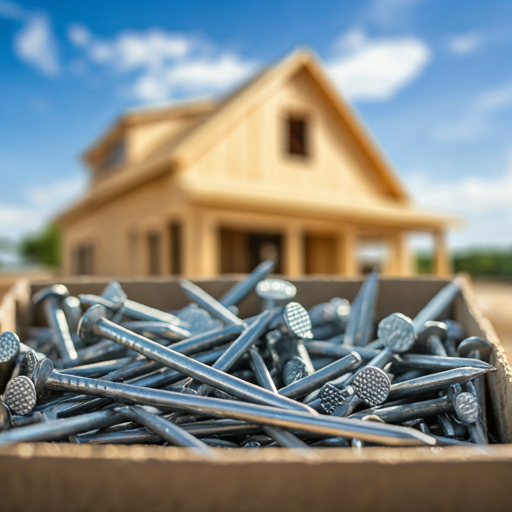You should take care of your house’s roofing. It makes it look better, saves energy, and keeps out the rain. Installing siding requires the right tools and nails to ensure the structure stays strong. Both professionals and people who do their projects need to know how to use panel nails correctly.
This article discusses siding nails extensively. It also discusses vinyl siding vs. other types of siding and construction tools, such as the siding nail gun, and how to pick the right nails for siding.

Are Nails for Siding?
Exterior siding nails are used to hold panels to a house. The thinner and longer nails allow for driving them through sheathing and walls without damaging them. If you use wall nails outside, they need to withstand rust. Long-lasting nails made of stainless steel or galvanized steel are popular.
Different Types of Siding
Learn about the different types of building siding before you learn about nails and nail guns. The most frequent panel types are:
- Vinyl siding is a popular house siding option due to its affordability, durability, and ease of maintenance. Colors and patterns abound.
- Wood siding is a classic and attractive siding that requires regular maintenance. However, weather, insects, and rot threaten it.
- Fibre cement siding: Cement, sand, and cellulose make fibre cement siding. It is bendable and robust and resembles wood.
- Aluminum siding is lightweight and rust-resistant. Because of its durability, it’s utilized to repair older homes.
- Engineered wood siding: It looks like wood but is sturdy and low-maintenance.
It is made from resin and wood strands.
For fitting, each material needs a different set of nails and tools. Let’s compare wall nail guns and nails for these things.
How to use a siding nail gun?
Power tools like siding nail guns hammer nails into building materials quickly. Nail guns make siding installation faster and easier. They drive all nails to the same depth to stabilize the siding while letting it expand and contract with the weather.
Siding nail guns work differently with different power sources.
Pneumatic Nail Gun: compressed air powers, pneumatic wall nailers. Professional siding installers use this method most often and effectively. Air-powered nail guns can drive nails into wood and fiber cement.
Electric Side Nail Gun: These nail guns have cords or batteries.
Gas-powered nail guns: Electric nail guns are smaller and easier to handle than pneumatic ones for light-duty tasks. They are siding nail guns that run on gas fire nails from small gas tanks. Because they are movable and don’t need a compressor, they are perfect for mobile use. You might have to work more on petrol tanks because they cost more.
Sorting Correctly for Siding Nail
To ensure durability, use the proper siding nails. Consider your siding and weather while choosing nails. Consider these factors while buying wall nails:
- Siding nails should not rust. Galvanized nails are zinc-coated to prevent rust. Stainless steel nails work well in damp or near-water dwellings.
- The thickness of the wood and the underlying material determine the length of the siding nails. The nails are longer to go through the framework and secure the siding, from 1.5 to 2 inches.
- A nail’s body, or stem, is called its shank. Ring-shank nails are often used for siding because their ridged shank makes them easier to grip and lessens nail looseness.
- Head Type: The head of a wall nail is the flat part that sticks out from the siding. Smaller heads may look better but must be big enough to hold the covering.
- A nail gauge measures the size of the nails. When larger nails (lower gauge numbers) are used, siding that is thinner and stronger may break. Eleven—and twelve-gauge nails are used for siding.
Why do most people choose a vinyl panel nail gun?
Vinyl siding is a common building material that needs to be put up in a certain way. Nail tools that work with vinyl siding are great for this. This is why:
Use uniform depth instead of pushing the nails too hard when putting up vinyl siding. Vinyl needs room to grow and shrink as the temperature changes. If you use a vinyl siding nail gun correctly, you can keep the siding from being too tight or too free.
Time and Work: Vinyl siding nail guns make construction go faster. When you use a nail gun instead of putting nails in, you save time and work.
Less Damage: If you don’t use the proper nails, you can crack or destroy vinyl flooring. A vinyl flooring nail gun’s steady pressure helps keep installation damage minimal.
When using a nail gun, leave a little room between the nail head and the vinyl siding so that the nail head can move. Nails shouldn’t be driven too deeply so that the vinyl doesn’t get warped.
A Range of Siding Nail Guns
Is an all-purpose nail gun useful for putting up siding? While some nail guns can be used for many things, siding nail guns are only meant for installing panels. This is why:
Depth Control: Nail guns for siding can be set to drive nails to the proper depth for different types of paneling. This stops too much penetration, which could hurt the wall or make it harder to extend.
Power: Pneumatic siding nail guns are made to drive nails into fiber cement and wood. Some nail guns might not have enough energy for these tasks.
Longer and thinner nails are made for wall nail guns.
Using the right tools can avoid damaging the siding or building and get a skilled finish.
Common Mistakes With a Siding Nail Gun
Putting up siding needs to be done carefully; even small mistakes can lead to problems. Do not make these mistakes with your nail gun for siding:
If you nail vinyl flooring down too deeply, it will get damaged. Ensure that the nail gun level is set correctly so the nails go deep enough into the siding to hold it in place without getting in the way of its movement.
Incorrect Nails: If you use the wrong nail, it could rust, corrode, or come free. To cover, use galvanized, stainless steel, or other nails that won’t rust.
If you nail wall panels too close to the edge, easily broken materials, like fiber cement or old vinyl, will split or break. Never use anything else but the nailing hem. It keeps nails in place without hurting the siding.
Safety first: Nail guns can be dangerous if used incorrectly. When using a nail gun, always wear gloves and masks and follow the maker’s instructions.

Choosing the Right Tools and Nails for Siding
Correct siding repair requires the proper nails and tools. A siding nail gun improves speed, simplicity, and precision for metal, wood, vinyl, or fibre cement work. Choose rust-resistant stainless steel or galvanized steel nails to prolong siding life.
If you know how to handle siding nails, nail guns, and installation, you can do any siding work, from minor repairs to major construction. The correct tools, materials, and expertise can create a polished surface. Have fun siding!
FAQs
What nails are used on siding?
Only use corrosion-resistant nails (aluminum, stainless, galvanized roofing). The minimum nail head diameter is 5/16″. CertainTeed recommends stainless steel nails or other corrosion-resistant fasteners for siding installation in coastal areas.
Is nailing into siding acceptable?
Drill or nail into your siding once you are satisfied with how your objects will be positioned in terms of structural integrity and visual appeal. Make sure you select the correct size of screw or nail based on the weight of the object you are working with.
Do siding nails rust?
The type of galvanization varies, with the best being hot-dipped galvanized and the least expensive mechanically plated, hot, and electroplated galvanized. They will likely eventually have varied degrees of rust in different places except hot-dipped.
For more tips, keep visiting ImprovementOfHome.com.

